Solar eclipse of November 11, 1901
| Solar eclipse of November 11, 1901 | |
|---|---|
 Map | |
| Type of eclipse | |
| Nature | Annular |
| Gamma | 0.4758 |
| Magnitude | 0.9216 |
| Maximum eclipse | |
| Duration | 661 sec (11 m 1 s) |
| Coordinates | 10°48′N 68°54′E / 10.8°N 68.9°E |
| Max. width of band | 336 km (209 mi) |
| Times (UTC) | |
| Greatest eclipse | 7:28:21 |
| References | |
| Saros | 141 (17 of 70) |
| Catalog # (SE5000) | 9284 |
An annular solar eclipse occurred on November 11, 1901. A solar eclipse occurs when the Moon passes between Earth and the Sun, thereby totally or partly obscuring the image of the Sun for a viewer on Earth. An annular solar eclipse occurs when the Moon's apparent diameter is smaller than the Sun's, blocking most of the Sun's light and causing the Sun to look like an annulus (ring). An annular eclipse appears as a partial eclipse over a region of the Earth thousands of kilometres wide.
Related eclipses
Solar eclipses 1901-1902
Each member in a semester series of solar eclipses repeats approximately every 177 days and 4 hours (a semester) at alternating nodes of the Moon's orbit.
| Descending node | Ascending node | |||
|---|---|---|---|---|
| 136 | May 18, 1901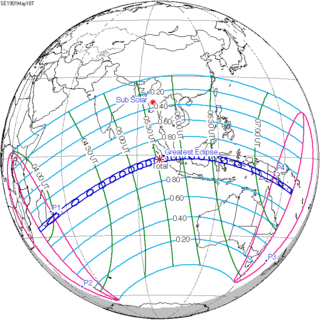 Total |
141 | November 11, 1901 Annular | |
| 146 | May 7, 1902 Partial |
151 | October 31, 1902 Partial | |
Saros 141
Solar Saros 141 repeats every 18 years, 11 days and contains 70 events. The series started with partial solar eclipse on May 19, 1613. It contains annular eclipses from August 4, 1739 through October 14, 2460. There are no total eclipses in this series. The series ends at member 70 as a partial eclipse on June 13, 2857. [1]
| Series members 17–28 occur between 1901 and 2100 | ||
|---|---|---|
| 17 | 18 | 19 |
 November 11, 1901 |
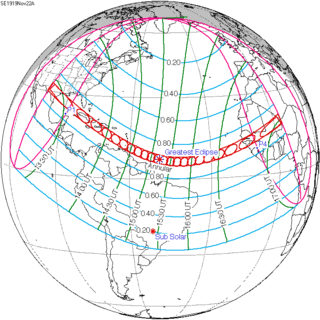 November 22, 1919 |
 December 2, 1937 |
| 20 | 21 | 22 |
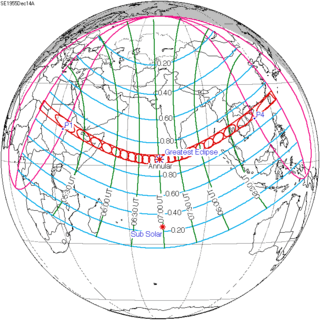 December 14, 1955 |
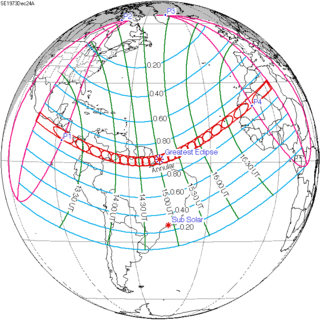 December 24, 1973 |
 January 4, 1992 |
| 23 | 24 | 25 |
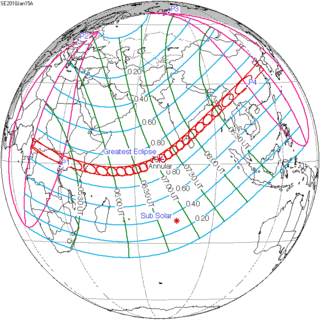 January 15, 2010 |
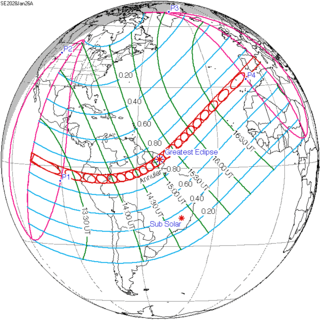 January 26, 2028 |
 February 5, 2046 |
| 26 | 27 | 28 |
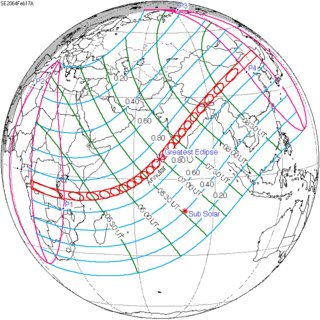 February 17, 2064 |
 February 27, 2082 |
 March 10, 2100 |
Notes
- ↑ "NASA - Catalog of Solar Eclipses of Saros 141". Eclipse.gsfc.nasa.gov. Retrieved 2012-03-15.
References
- Earth visibility chart and eclipse statistics Eclipse Predictions by Fred Espenak, NASA/GSFC
| Wikimedia Commons has media related to Solar eclipse of 1901 November 11. |
